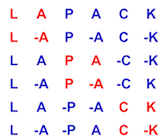194 SUBROUTINE sbdsdc( UPLO, COMPQ, N, D, E, U, LDU, VT, LDVT, Q,
196 $ WORK, IWORK, INFO )
203 CHARACTER COMPQ, UPLO
204 INTEGER INFO, LDU, LDVT, N
207 INTEGER IQ( * ), IWORK( * )
208 REAL D( * ), E( * ), Q( * ), U( LDU, * ),
209 $ vt( ldvt, * ), work( * )
219 PARAMETER ( ZERO = 0.0e+0, one = 1.0e+0, two = 2.0e+0 )
222 INTEGER DIFL, DIFR, GIVCOL, GIVNUM, GIVPTR, I, IC,
223 $ ICOMPQ, IERR, II, IS, IU, IUPLO, IVT, J, K, KK,
224 $ mlvl, nm1, nsize, perm, poles, qstart, smlsiz,
225 $ smlszp, sqre, start, wstart, z
226 REAL CS, EPS, ORGNRM, P, R, SN
232 EXTERNAL slamch, slanst, ilaenv, lsame
240 INTRINSIC real, abs, int, log, sign
249 IF( lsame( uplo,
'U' ) )
251 IF( lsame( uplo,
'L' ) )
253 IF( lsame( compq,
'N' ) )
THEN
255 ELSE IF( lsame( compq,
'P' ) )
THEN
257 ELSE IF( lsame( compq,
'I' ) )
THEN
262 IF( iuplo.EQ.0 )
THEN
264 ELSE IF( icompq.LT.0 )
THEN
266 ELSE IF( n.LT.0 )
THEN
268 ELSE IF( ( ldu.LT.1 ) .OR. ( ( icompq.EQ.2 ) .AND. ( ldu.LT.
271 ELSE IF( ( ldvt.LT.1 ) .OR. ( ( icompq.EQ.2 ) .AND. ( ldvt.LT.
276 CALL xerbla(
'SBDSDC', -info )
284 smlsiz = ilaenv( 9,
'SBDSDC',
' ', 0, 0, 0, 0 )
286 IF( icompq.EQ.1 )
THEN
287 q( 1 ) = sign( one, d( 1 ) )
288 q( 1+smlsiz*n ) = one
289 ELSE IF( icompq.EQ.2 )
THEN
290 u( 1, 1 ) = sign( one, d( 1 ) )
293 d( 1 ) = abs( d( 1 ) )
303 IF( icompq.EQ.1 )
THEN
304 CALL scopy( n, d, 1, q( 1 ), 1 )
305 CALL scopy( n-1, e, 1, q( n+1 ), 1 )
307 IF( iuplo.EQ.2 )
THEN
309 IF( icompq .EQ. 2 ) wstart = 2*n - 1
311 CALL slartg( d( i ), e( i ), cs, sn, r )
314 d( i+1 ) = cs*d( i+1 )
315 IF( icompq.EQ.1 )
THEN
318 ELSE IF( icompq.EQ.2 )
THEN
327 IF( icompq.EQ.0 )
THEN
331 CALL slasdq(
'U', 0, n, 0, 0, 0, d, e, vt, ldvt, u, ldu, u,
332 $ ldu, work( 1 ), info )
339 IF( n.LE.smlsiz )
THEN
340 IF( icompq.EQ.2 )
THEN
341 CALL slaset(
'A', n, n, zero, one, u, ldu )
342 CALL slaset(
'A', n, n, zero, one, vt, ldvt )
343 CALL slasdq(
'U', 0, n, n, n, 0, d, e, vt, ldvt, u, ldu,
345 $ ldu, work( wstart ), info )
346 ELSE IF( icompq.EQ.1 )
THEN
349 CALL slaset(
'A', n, n, zero, one,
350 $ q( iu+( qstart-1 )*n ),
352 CALL slaset(
'A', n, n, zero, one,
353 $ q( ivt+( qstart-1 )*n ),
355 CALL slasdq(
'U', 0, n, n, n, 0, d, e,
356 $ q( ivt+( qstart-1 )*n ), n,
357 $ q( iu+( qstart-1 )*n ), n,
358 $ q( iu+( qstart-1 )*n ), n, work( wstart ),
364 IF( icompq.EQ.2 )
THEN
365 CALL slaset(
'A', n, n, zero, one, u, ldu )
366 CALL slaset(
'A', n, n, zero, one, vt, ldvt )
371 orgnrm = slanst(
'M', n, d, e )
374 CALL slascl(
'G', 0, 0, orgnrm, one, n, 1, d, n, ierr )
375 CALL slascl(
'G', 0, 0, orgnrm, one, nm1, 1, e, nm1, ierr )
377 eps = slamch(
'Epsilon' )
379 mlvl = int( log( real( n ) / real( smlsiz+1 ) ) / log( two ) ) + 1
382 IF( icompq.EQ.1 )
THEN
391 givnum = poles + 2*mlvl
400 IF( abs( d( i ) ).LT.eps )
THEN
401 d( i ) = sign( eps, d( i ) )
409 IF( ( abs( e( i ) ).LT.eps ) .OR. ( i.EQ.nm1 ) )
THEN
418 nsize = i - start + 1
419 ELSE IF( abs( e( i ) ).GE.eps )
THEN
423 nsize = n - start + 1
430 nsize = i - start + 1
431 IF( icompq.EQ.2 )
THEN
432 u( n, n ) = sign( one, d( n ) )
434 ELSE IF( icompq.EQ.1 )
THEN
435 q( n+( qstart-1 )*n ) = sign( one, d( n ) )
436 q( n+( smlsiz+qstart-1 )*n ) = one
438 d( n ) = abs( d( n ) )
440 IF( icompq.EQ.2 )
THEN
441 CALL slasd0( nsize, sqre, d( start ), e( start ),
442 $ u( start, start ), ldu, vt( start, start ),
443 $ ldvt, smlsiz, iwork, work( wstart ), info )
445 CALL slasda( icompq, smlsiz, nsize, sqre, d( start ),
446 $ e( start ), q( start+( iu+qstart-2 )*n ), n,
447 $ q( start+( ivt+qstart-2 )*n ),
448 $ iq( start+k*n ), q( start+( difl+qstart-2 )*
449 $ n ), q( start+( difr+qstart-2 )*n ),
450 $ q( start+( z+qstart-2 )*n ),
451 $ q( start+( poles+qstart-2 )*n ),
452 $ iq( start+givptr*n ), iq( start+givcol*n ),
453 $ n, iq( start+perm*n ),
454 $ q( start+( givnum+qstart-2 )*n ),
455 $ q( start+( ic+qstart-2 )*n ),
456 $ q( start+( is+qstart-2 )*n ),
457 $ work( wstart ), iwork, info )
468 CALL slascl(
'G', 0, 0, one, orgnrm, n, 1, d, n, ierr )
478 IF( d( j ).GT.p )
THEN
486 IF( icompq.EQ.1 )
THEN
488 ELSE IF( icompq.EQ.2 )
THEN
489 CALL sswap( n, u( 1, i ), 1, u( 1, kk ), 1 )
490 CALL sswap( n, vt( i, 1 ), ldvt, vt( kk, 1 ), ldvt )
492 ELSE IF( icompq.EQ.1 )
THEN
499 IF( icompq.EQ.1 )
THEN
500 IF( iuplo.EQ.1 )
THEN
510 IF( ( iuplo.EQ.2 ) .AND. ( icompq.EQ.2 ) )
511 $
CALL slasr(
'L',
'V',
'B', n, n, work( 1 ), work( n ), u,

